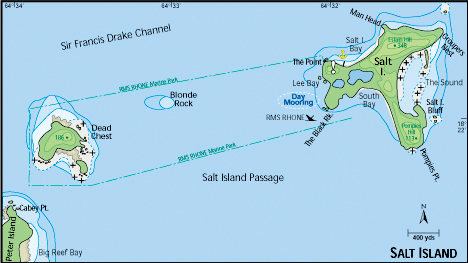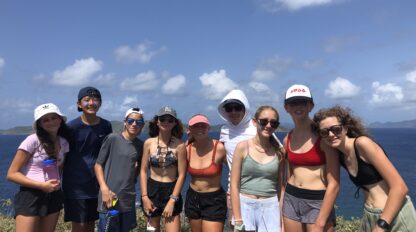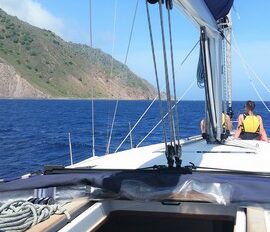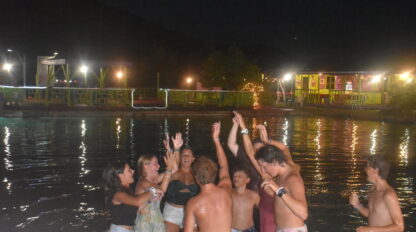144th Anniversary of the Sinking of the RMS Rhone

On October 19, 1867, the Rhone found herself anchored in Great Harbor, Peter Island next to the RMS Conway to refuel. The coaling station had been temporarily relocated from St. Thomas, USVI due to outbreaks of yellow fever. The ships remained in harbor for over a week, and on October 29, 1867 the captains of both ships became nervous as the barometric pressure dropped, indicating a coming storm. The captains agreed that it was too late in the year to be a hurricane and decided to weather out the storm in Great Harbour. However, just to be on the safe side, all passengers were transferred from the Conway to the larger and safer, unsinkable Rhone.
Storm clouds continued to build, looming ominously as the barometer read lower and lower pressures. Before long, the wind began to whip through the air until both ships strained against their anchors. It turned out that the storm was not just an early winter storm as the captains had suspected, but rather a Category 3 hurricane later named San Narciso. Captain Wooley ordered the boilers be fired up so the Rhone could fight against the force of the wind and hopefully remain secure on her anchorage. And fight she did! However, when the calm came, both ships had dragged anchor and the captains were worried that when the winds returned their ships would be forced upon the rocks of Peter Island. The decision was made to leave the harbor while the storm rested over head and make a run for the more protected Road Harbour, across the channel on Tortola.
The Conway raised anchor quickly, and set off into the agitated waters of the Sir Francis Drake Channel. Rhone tried to follow suit, but during the first half of the storm her anchor chain had become wrapped around a large coral head and wedged tightly. Try as they might, the crew was unable to dislodge the enormous anchor – they all knew they were running out of time before the storm would be upon them once again. Captain Wooley ordered the 3000 lb anchor to be cut, and so 300 feet of chain dropped to the bottom of Great Harbour where it still lies to this very day. After a century and a half, it is now as much a part of the reef habitat as the original coral around which it is still wrapped.
 By this time, the Conway was well on its way across the channel, and Captain Wooley realized that his next decision would be critical. The barometer began to drop once more and Wooley made the call to head to open sea where there was no risk of foundering upon the shore of nearby islands or the shallow reefs surrounding them. The closest exit to open sea was head North and go through the cut between Dead Chest Island and Black Rock Point on Salt Island (Photo cred: cruisingthevirginislands.com). Wooley knew that Blonde Rock, a reef typically submerged 25 ft, could potentially be dangerous with the large hurricane swell, so the captain planned to give the reef a conservatively wide berth which would take the Rhone ever closer to Black Rock Point. As was typical protocol of the day, all passengers were tied securely into their beds to protect them from the rough hurricane seas they were bound for.
By this time, the Conway was well on its way across the channel, and Captain Wooley realized that his next decision would be critical. The barometer began to drop once more and Wooley made the call to head to open sea where there was no risk of foundering upon the shore of nearby islands or the shallow reefs surrounding them. The closest exit to open sea was head North and go through the cut between Dead Chest Island and Black Rock Point on Salt Island (Photo cred: cruisingthevirginislands.com). Wooley knew that Blonde Rock, a reef typically submerged 25 ft, could potentially be dangerous with the large hurricane swell, so the captain planned to give the reef a conservatively wide berth which would take the Rhone ever closer to Black Rock Point. As was typical protocol of the day, all passengers were tied securely into their beds to protect them from the rough hurricane seas they were bound for.
As the ship safely maneuvered Blonde Rock, and set her course directly out to see, you can imagine the preemptive sighs of relief from the crew. The good English Captain Wooley was even said to have been celebrating with a cup of hot tea which he was stirring with a silver teaspoon. Only 250 yards from safety, the Rhone was passing Black Rock Point when the second part of the storm rose up from the south with a vengeance. The abruptly shifting winds reached up to 130 mph at its peak and shoved the Rhone forcefully onto Black Rock Point. The jolt sent Captain Wooley directly overboard, never to be seen again. His silver teaspoon is said to still be lodged in the wreck, and whether it is his or not, a coral encrusted teaspoon is in fact clearly visible to divers who look for it. The force of the crash caused the ship to split in two, and as the cold sea water rushed in it made contact with the fiery boilers which subsequently exploded.
 The RMS Rhone, with huge wounds in her majestic beam, sank swiftly and her bow came gently to rest in eighty feet of water, her stern in thirty. 146 people boarded the her in England, plus an unknown number of passengers who transferred from the Conway. Of these, only 23 people (all crew) survived the wreck. The bodies of the sailors that were recovered were buried in a cemetery on Salt Island, and any bones that continue to be unearthed from the wreck are always added respectfully to the cemetery (Photo cred: sailingjeannius.blogspot.com). The residents of Salt Island helped to shore as many people as they could, for which the Queen showed her gratitude by giving the family and their heirs the whole island in exchange for one bag of salt per year. This is still the rent for the descendants who live there. Some survivors, however, were not washed upon the shore until they had floated across the entire channel onto Beef Island. One crew member is even reported to have survived by clinging for 20 hours to the topmast which was still standing.
The RMS Rhone, with huge wounds in her majestic beam, sank swiftly and her bow came gently to rest in eighty feet of water, her stern in thirty. 146 people boarded the her in England, plus an unknown number of passengers who transferred from the Conway. Of these, only 23 people (all crew) survived the wreck. The bodies of the sailors that were recovered were buried in a cemetery on Salt Island, and any bones that continue to be unearthed from the wreck are always added respectfully to the cemetery (Photo cred: sailingjeannius.blogspot.com). The residents of Salt Island helped to shore as many people as they could, for which the Queen showed her gratitude by giving the family and their heirs the whole island in exchange for one bag of salt per year. This is still the rent for the descendants who live there. Some survivors, however, were not washed upon the shore until they had floated across the entire channel onto Beef Island. One crew member is even reported to have survived by clinging for 20 hours to the topmast which was still standing.
The Conway, ironically enough, also grounded in Baugher’s Bay in Road Harbour. This bay, however, is composed of a gently sloping seagrass bed and caused no significant damage to the ship or crew – she was later refloated. The San Narciso Hurricane is considered one of the worst in West Indies history, and was by far the most destructive storm faced that year. On the land, only 3 houses remained standing in the BVI and 36 people were killed. On the water, only 2 ships remained afloat out of 275 that had been in the area.
In the 1950s, the British Royal Navy deemed the still standing topmast and shallow stern to be a safety hazard. Her stern section was blown apart to remove this hazard which is why you see mainly a pile of rubble in the shallow section of the wreck dive. In 1967, 100 years after she went down, the area was dubbed a National Marine Park. There is also a memorial to the RMS Rhone in the Southampton Old Cemetery in England (Check out the photos in the Sail Caribbean Divers Photo Gallery).
These days, the Rhone is a spectacularly famous dive site considered to be one of the very best in the Caribbean. Sail Caribbean’s teen scuba diving programs offer an exceptional opportunity to earn a PADI certified diving specialty specific to the Wreck of the Rhone. The RMS Rhone Diver specialty is exclusive to Sail Caribbean Divers and is offered to anyone who has an Advanced Open Water certification and is 15 years or older.
(Photo cred: divebvi.com)
It takes at least two dives to explore the wreck, though people have been known to dive it hundreds of times and always find something new. There are still many artifacts to be seen, large portions of the structure still intact (including the Lucky Porthole), a lovely swim through in the bow section of the ship, and tons of marine life (including Fang, the local barracuda) using the wreckage as their home. Nearly every solid surface is painted in red, yellow, and orange hues by the myriad of corals and sponges. At night the ghostly ship is transformed into a wonderland of living beauty as the many different kinds of corals and other exciting invertebrates reach out to feed.
 No other ships have run aground at Black Rock Point until (believe it or not!) the end of this summer. Around 10:00pm on August 28, 2011, the Tropical Sun, a Tropical Shipping vessel, ran over the shallow moorings and aground, just to the left of the Wreck of the Rhone. It was moving at a slow speed, but appeared to have made no effort to slow down before impact. The dive site was closed for 10 days while local authorities, Conservation and Fisheries, and the shipping company investigated and assessed the situation and made a plan to remove the ship. Miraculously, the hull of the ship was not damaged significantly enough to cause any spills or leaks, only a small section of coral was injured, and the Rhone was not touched in the slightest! The Tropical Sun was promptly removed and the Rhone National Marine Park was reopened. According to the Director of Sail Caribbean Divers, Melisande Rowe, healthy young corals are already starting to settle down and rebuild their little lives.
No other ships have run aground at Black Rock Point until (believe it or not!) the end of this summer. Around 10:00pm on August 28, 2011, the Tropical Sun, a Tropical Shipping vessel, ran over the shallow moorings and aground, just to the left of the Wreck of the Rhone. It was moving at a slow speed, but appeared to have made no effort to slow down before impact. The dive site was closed for 10 days while local authorities, Conservation and Fisheries, and the shipping company investigated and assessed the situation and made a plan to remove the ship. Miraculously, the hull of the ship was not damaged significantly enough to cause any spills or leaks, only a small section of coral was injured, and the Rhone was not touched in the slightest! The Tropical Sun was promptly removed and the Rhone National Marine Park was reopened. According to the Director of Sail Caribbean Divers, Melisande Rowe, healthy young corals are already starting to settle down and rebuild their little lives.
The beauty and mystery of the RMS Rhone awaits you beneath the surface of the waters surrounding Salt Island. Help us memorialize this day and the breath-taking dive site by sharing your own memories and adventures! And if you are hoping to dive the Wreck of the Rhone in Summer 2012, check out underwater photagrapher Armando Jenik’s Photo Gallery and get excited!
Photo Cred: Nate Formel
Primary sources include: Wikipedia, SailDiveBVI, BVI Platinum News, and Sail Caribbean Divers





